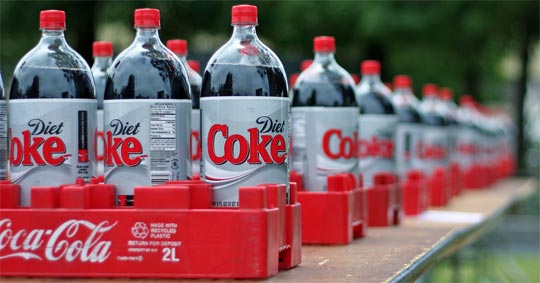Diet Coke is the third most popular soft drink in the United States with around 9% off the nation’s market share, behind regular Coke and Pepsi. (March 2011 update: Diet Coke has surpassed Pepsi for #2 in US market share).
As far as flavored, low-calorie water is concerned, Diet Coke is addicting. Before getting into natural food, it was a staple of my day. But I burned out, and then I changed my eating habits.
Ingredients in Diet Coke
Carbonated Water, Caramel Color, Aspartame, Phosphoric Acid, Potassium Benzoate (to protect taste), Natural Flavors, Citric Acid, Caffeine

Aspartame
The major difference between regular Coke and Diet Coke is the use of aspartame as an artificial sweetener. Aspartame is a controversial figure in the world of zero-calorie sweeteners. Critics will tell you that it’s a significant health risks. Supports will say that the proof of its safety is in the millions of drinkers who haven’t suffered any apparent problems.
Caramel color
Diet Coke’s brown comes from ammonia-process caramel color. Critics argue that ammonia-processed caramel color should not be labeled as a natural additive. They also play up health risks associated with this grade of coloring — chemical reactions result in the formation of 2-methylimidazole and 4 methylimidazole, two molecules identified as potential carcinogens in a study with lab rats.
Phosphoric acid
Used to give Diet Coke a tangy taste. Phosphoric acid is naturally present in ginger and lemons. In higher concentrations, it’s also used as an industrial cleaner.
Potassium benzoate
Potassium benzoate is the hallmark preservative of low-pH (high acid) sodas. It inhibits the growth of bacteria and mold, giving your carbonated beverage a long shelf life. There is health danger with potassium benzoate — benzoic acid will naturally convert to benzene, a known carcinogen. This reaction is promoted by ascorbic acid, so it’s probably a good thing that it is absent from Diet Coke’s ingredients. Heat and light, however, can also propagate the conversion to benzene.